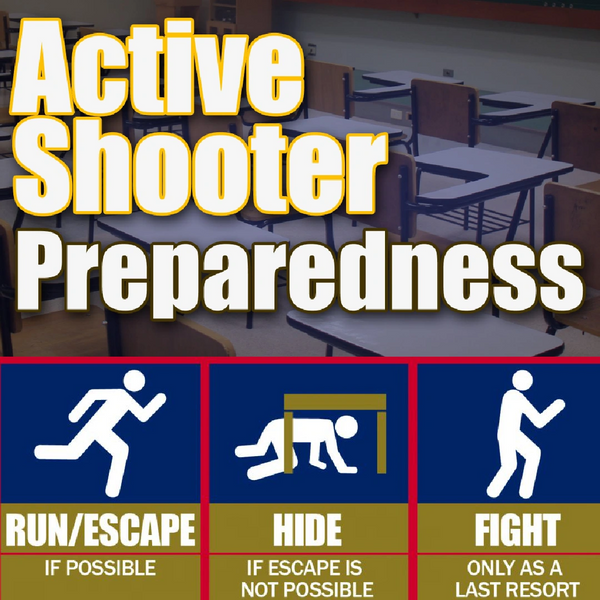The Importance of Active Shooter Training in High-Risk Environments
The Importance of Active Shooter Training in High-Risk Environments
Blog Article
Checking Out the Key Parts and Purposes of Efficient Active Shooter Training Programs
Active shooter training programs are essential in gearing up people and companies with the required skills to respond efficiently to prospective risks. These programs incorporate important components, such as the "Run, Hide, Fight" method, realistic situation simulations, and interaction protocols, cultivating a setting of readiness. In addition, they emphasize emotional resilience to help individuals browse high-stress circumstances. As we explore the complexities of these training programs, it comes to be apparent that understanding their detailed nature is vital to improving precaution and reaction capacities. What details aspects really define their effectiveness?
Value of Energetic Shooter Training
Active shooter training programs are crucial for boosting readiness and feedback when faced with possible threats. These programs intend to outfit people, organizations, and neighborhoods with the understanding and skills essential to successfully reply to active shooter circumstances. The boosting frequency and severity of such events emphasize the importance of aggressive procedures, as timely and educated responses can substantially alleviate damage.

Additionally, these programs can aid relieve the anxiety and worry that frequently accompany discussions concerning prospective hazards. By offering organized assistance and functional techniques, people gain confidence in their capability to react properly. Inevitably, the significance of active shooter training depends on its potential to save lives, decrease injuries, and grow a ready and resilient area with the ability of facing unpredicted obstacles.
Key Elements of Training Programs
Reliable energetic shooter training programs generally integrate numerous essential elements designed to prepare participants for real-world scenarios. The very first element is detailed education on the nature of energetic shooter incidents, consisting of data, case researches, and psychological factors that affect aggressors. This theoretical structure is important for cultivating recognition and understanding amongst participants.
Next, programs usually consist of training on individual safety and security procedures, stressing the "Run, Hide, Battle" method. Participants find out how to evaluate their environment, make fast choices, and take appropriate actions throughout a crisis. In addition, the incorporation of reliable communication skills is important, as participants need to comprehend exactly how to report events and share crucial info with legislation enforcement.
Another crucial component is the participation of legislation enforcement or security specialists, who give insights into tactical reactions and the significance of teamwork throughout a crisis. Programs must address the mental after-effects of an active shooter circumstance, offering approaches for coping and recuperation.
Finally, continuous training and refresher course training courses are critical to make sure that understanding continues to be present and participants really feel certain in their capacities. With each other, these key components produce an all-around training program that gears up individuals to respond efficiently to an active shooter event.
Realistic Situation Simulations
Practical scenario simulations are an important aspect of active shooter training programs, providing participants with the opportunity to participate in hands-on practice that mirrors potential real-life situations. These simulations improve the training experience by producing an immersive atmosphere where individuals can apply theoretical knowledge in useful settings.
Through making use of role-playing, mock situations, and specialized training facilities, participants experience the immediate challenges and stressors related to an active shooter incident. This method of training promotes quick decision-making, synergy, and the application of safety and security protocols under pressure. It allows responders to establish essential abilities such as situational recognition, risk evaluation, and reliable discharge treatments.
Moreover, reasonable simulations assist to determine prospective weaknesses in participants' reactions, enabling trainers to provide targeted feedback and boost official site total preparedness. The incorporation of differing circumstances, including different places and opponent accounts, further enriches the training experience, guaranteeing that participants are well-equipped to take care of a series of possible scenarios.
Eventually, these simulations serve not just to advise but also to construct self-confidence among individuals, cultivating a feeling of readiness that is important for reliable emergency situation action in the face of an energetic shooter threat. active shooter training.
Interaction Approaches in Training
Clear interaction is important in active shooter training programs, as it straight influences the effectiveness of feedback initiatives throughout a dilemma. Training participants need to comprehend the protocols and treatments that will guide their activities if faced with an energetic shooter circumstance. Establishing clear lines of interaction guarantees that all people included can pass on info without delay and accurately.

In addition, training programs must emphasize the relevance of active listening. Ultimately, reliable communication techniques are important for preparing people to react decisively and cohesively in the face of an active shooter incident.
Psychological Preparedness Strategies
Emotional preparedness techniques are progressively recognized as crucial elements of active shooter training programs. These methods aim to outfit people with the mental durability needed to respond properly in high-stress situations. By cultivating a way of thinking attuned to prospective hazards, individuals can much better manage concern, stress and anxiety, and complication anonymous throughout critical events.
Key emotional readiness approaches include scenario-based training and stress and anxiety inoculation workouts. Scenario-based training immerses participants in realistic simulations that simulate the chaos of an energetic shooter occasion, permitting them to practice decision-making under stress. This direct exposure aids construct knowledge with emergency situation protocols, enhancing instinctual reactions.
Stress and anxiety shot involves steady direct exposure to stress-inducing scenarios, enabling individuals to create coping devices. This can consist of breathing exercises, visualization strategies, and cognitive find more restructuring to reframe adverse thoughts. By integrating these techniques, training programs can cultivate a sense of confidence and control, which is crucial in situation circumstances.
Moreover, post-incident mental assistance is critical to deal with the emotional aftermath of an active shooter occasion. Including psychological health and wellness resources into training programs not only prepares individuals for prompt responses however additionally advertises long-lasting mental health, eventually adding to a safer and much more resistant setting.
Final Thought

Report this page